Recruitment and Selection Strategies: A Business Report
VerifiedAdded on 2023/01/13
|13
|3311
|20
Report
AI Summary
This report provides a detailed analysis of the recruitment and selection process, focusing on the hiring of a business management tutor at the University of Southampton. It begins by exploring the planning phase, differentiating between internal and external recruitment sources and their respective advantages. The report then delves into the legal and regulatory framework, highlighting key acts such as the Data Protection Act, Equality Act 2010, National Minimum Wage, and Working Time Directive, and their implications on recruitment activities. Furthermore, it presents the preparation of essential documents, including a person specification, job description, and curriculum vitae, crucial for attracting and evaluating potential candidates. The report concludes with a comprehensive plan for participating in the selection interview process, outlining pre and post-interview information for candidates, and emphasizing the importance of a well-structured approach to identify the most suitable candidate for the role.
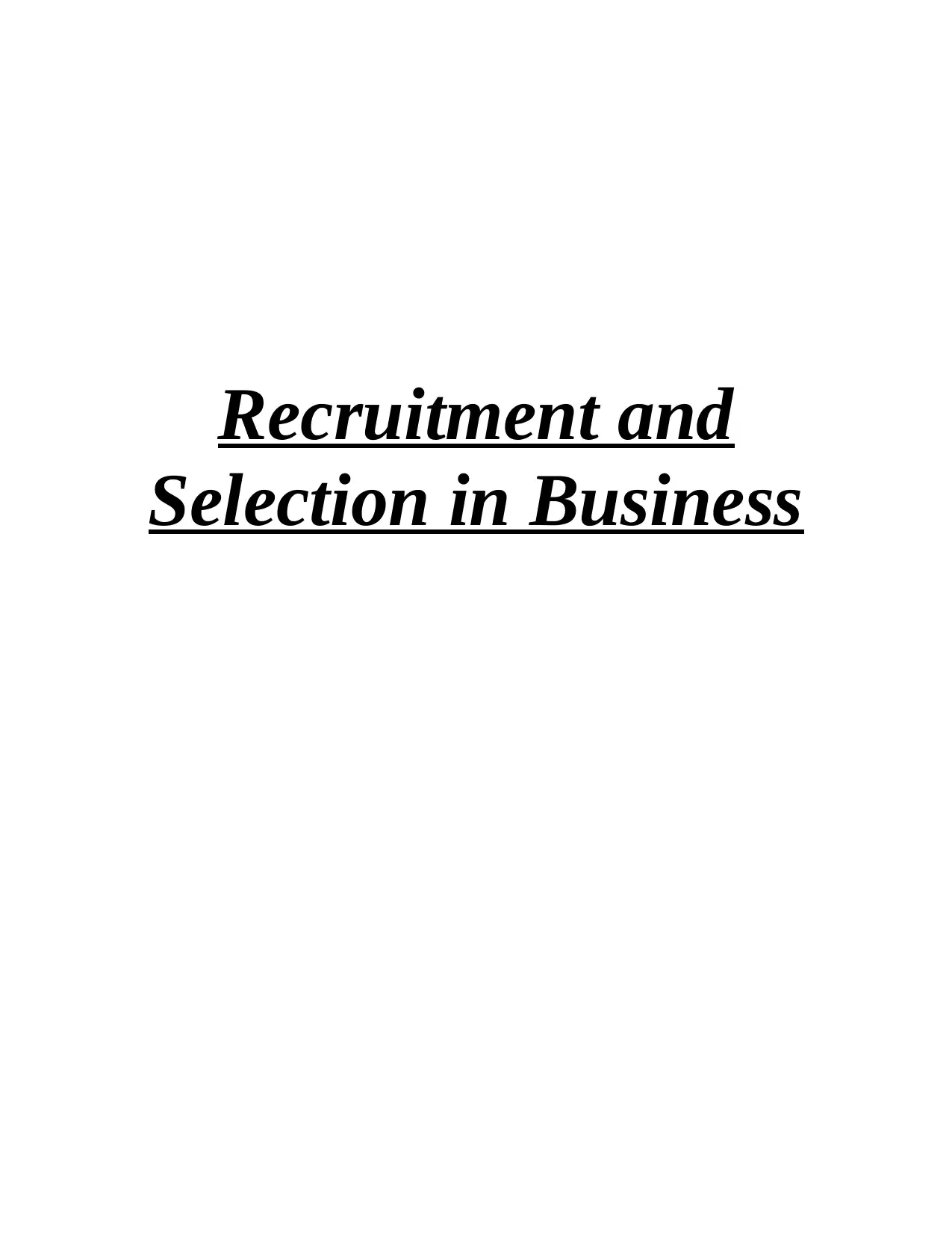
Recruitment and
Selection in Business
Selection in Business
Paraphrase This Document
Need a fresh take? Get an instant paraphrase of this document with our AI Paraphraser
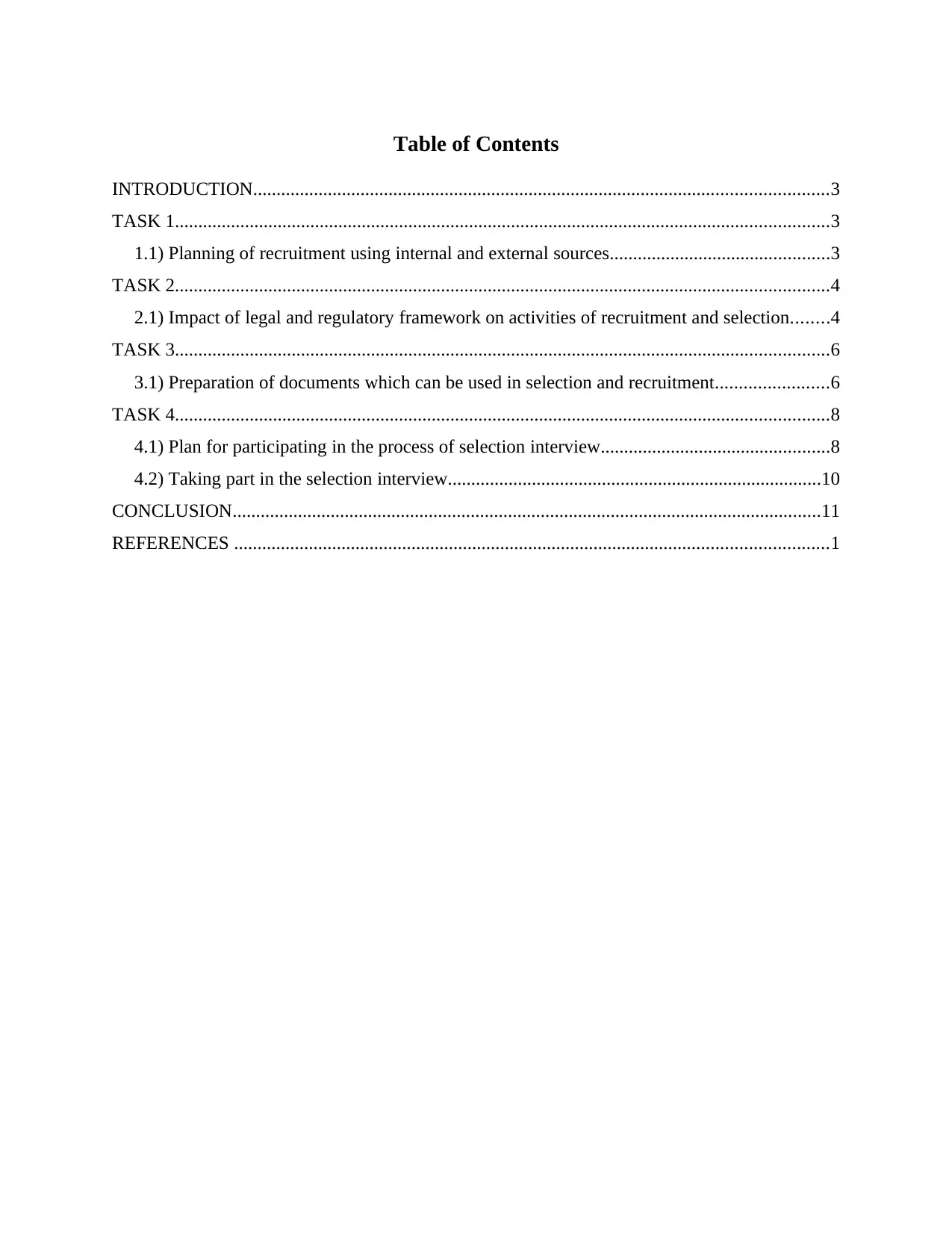
Table of Contents
INTRODUCTION...........................................................................................................................3
TASK 1............................................................................................................................................3
1.1) Planning of recruitment using internal and external sources...............................................3
TASK 2............................................................................................................................................4
2.1) Impact of legal and regulatory framework on activities of recruitment and selection........4
TASK 3............................................................................................................................................6
3.1) Preparation of documents which can be used in selection and recruitment........................6
TASK 4............................................................................................................................................8
4.1) Plan for participating in the process of selection interview.................................................8
4.2) Taking part in the selection interview................................................................................10
CONCLUSION..............................................................................................................................11
REFERENCES ...............................................................................................................................1
INTRODUCTION...........................................................................................................................3
TASK 1............................................................................................................................................3
1.1) Planning of recruitment using internal and external sources...............................................3
TASK 2............................................................................................................................................4
2.1) Impact of legal and regulatory framework on activities of recruitment and selection........4
TASK 3............................................................................................................................................6
3.1) Preparation of documents which can be used in selection and recruitment........................6
TASK 4............................................................................................................................................8
4.1) Plan for participating in the process of selection interview.................................................8
4.2) Taking part in the selection interview................................................................................10
CONCLUSION..............................................................................................................................11
REFERENCES ...............................................................................................................................1

⊘ This is a preview!⊘
Do you want full access?
Subscribe today to unlock all pages.

Trusted by 1+ million students worldwide
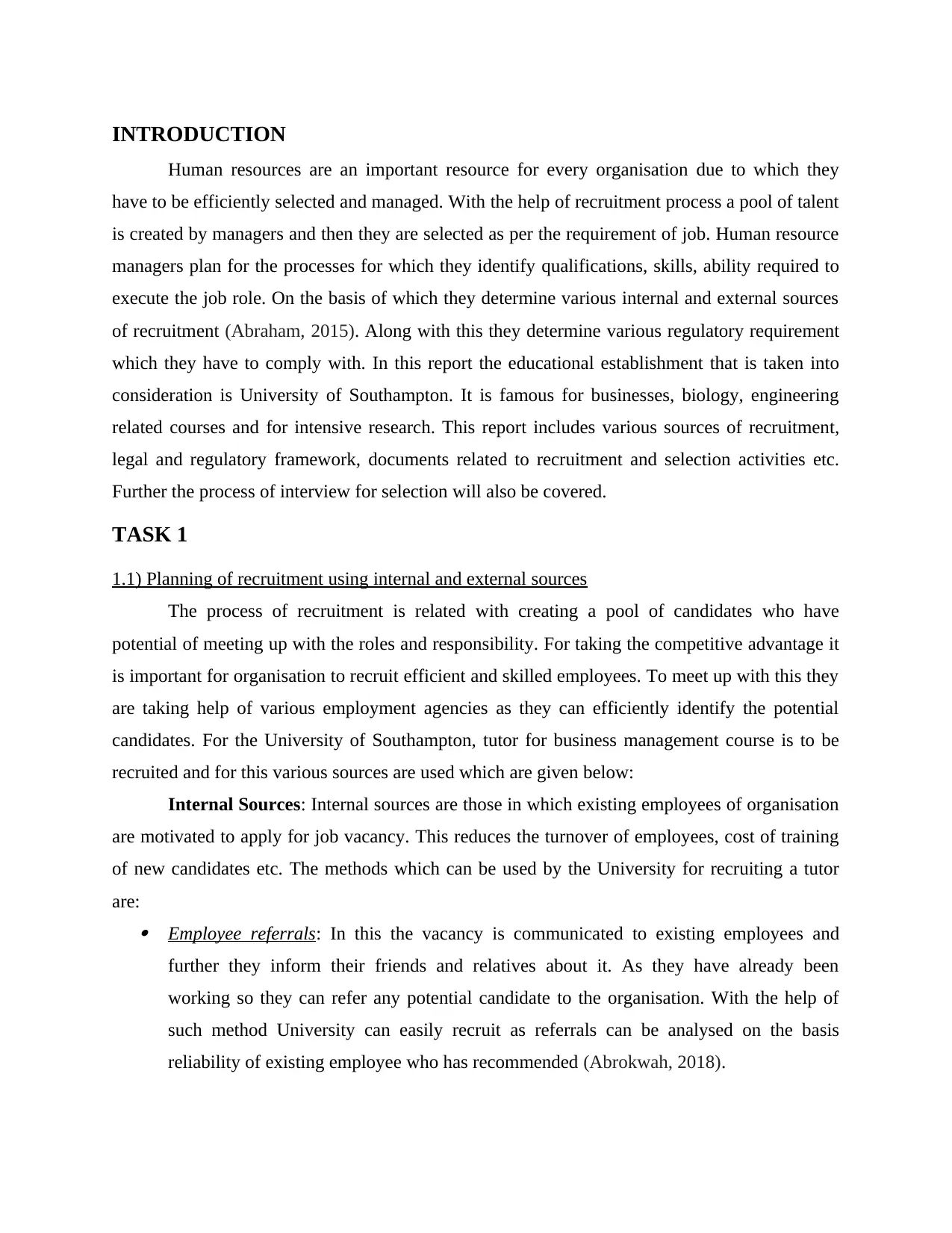
INTRODUCTION
Human resources are an important resource for every organisation due to which they
have to be efficiently selected and managed. With the help of recruitment process a pool of talent
is created by managers and then they are selected as per the requirement of job. Human resource
managers plan for the processes for which they identify qualifications, skills, ability required to
execute the job role. On the basis of which they determine various internal and external sources
of recruitment (Abraham, 2015). Along with this they determine various regulatory requirement
which they have to comply with. In this report the educational establishment that is taken into
consideration is University of Southampton. It is famous for businesses, biology, engineering
related courses and for intensive research. This report includes various sources of recruitment,
legal and regulatory framework, documents related to recruitment and selection activities etc.
Further the process of interview for selection will also be covered.
TASK 1
1.1) Planning of recruitment using internal and external sources
The process of recruitment is related with creating a pool of candidates who have
potential of meeting up with the roles and responsibility. For taking the competitive advantage it
is important for organisation to recruit efficient and skilled employees. To meet up with this they
are taking help of various employment agencies as they can efficiently identify the potential
candidates. For the University of Southampton, tutor for business management course is to be
recruited and for this various sources are used which are given below:
Internal Sources: Internal sources are those in which existing employees of organisation
are motivated to apply for job vacancy. This reduces the turnover of employees, cost of training
of new candidates etc. The methods which can be used by the University for recruiting a tutor
are: Employee referrals: In this the vacancy is communicated to existing employees and
further they inform their friends and relatives about it. As they have already been
working so they can refer any potential candidate to the organisation. With the help of
such method University can easily recruit as referrals can be analysed on the basis
reliability of existing employee who has recommended (Abrokwah, 2018).
Human resources are an important resource for every organisation due to which they
have to be efficiently selected and managed. With the help of recruitment process a pool of talent
is created by managers and then they are selected as per the requirement of job. Human resource
managers plan for the processes for which they identify qualifications, skills, ability required to
execute the job role. On the basis of which they determine various internal and external sources
of recruitment (Abraham, 2015). Along with this they determine various regulatory requirement
which they have to comply with. In this report the educational establishment that is taken into
consideration is University of Southampton. It is famous for businesses, biology, engineering
related courses and for intensive research. This report includes various sources of recruitment,
legal and regulatory framework, documents related to recruitment and selection activities etc.
Further the process of interview for selection will also be covered.
TASK 1
1.1) Planning of recruitment using internal and external sources
The process of recruitment is related with creating a pool of candidates who have
potential of meeting up with the roles and responsibility. For taking the competitive advantage it
is important for organisation to recruit efficient and skilled employees. To meet up with this they
are taking help of various employment agencies as they can efficiently identify the potential
candidates. For the University of Southampton, tutor for business management course is to be
recruited and for this various sources are used which are given below:
Internal Sources: Internal sources are those in which existing employees of organisation
are motivated to apply for job vacancy. This reduces the turnover of employees, cost of training
of new candidates etc. The methods which can be used by the University for recruiting a tutor
are: Employee referrals: In this the vacancy is communicated to existing employees and
further they inform their friends and relatives about it. As they have already been
working so they can refer any potential candidate to the organisation. With the help of
such method University can easily recruit as referrals can be analysed on the basis
reliability of existing employee who has recommended (Abrokwah, 2018).
Paraphrase This Document
Need a fresh take? Get an instant paraphrase of this document with our AI Paraphraser
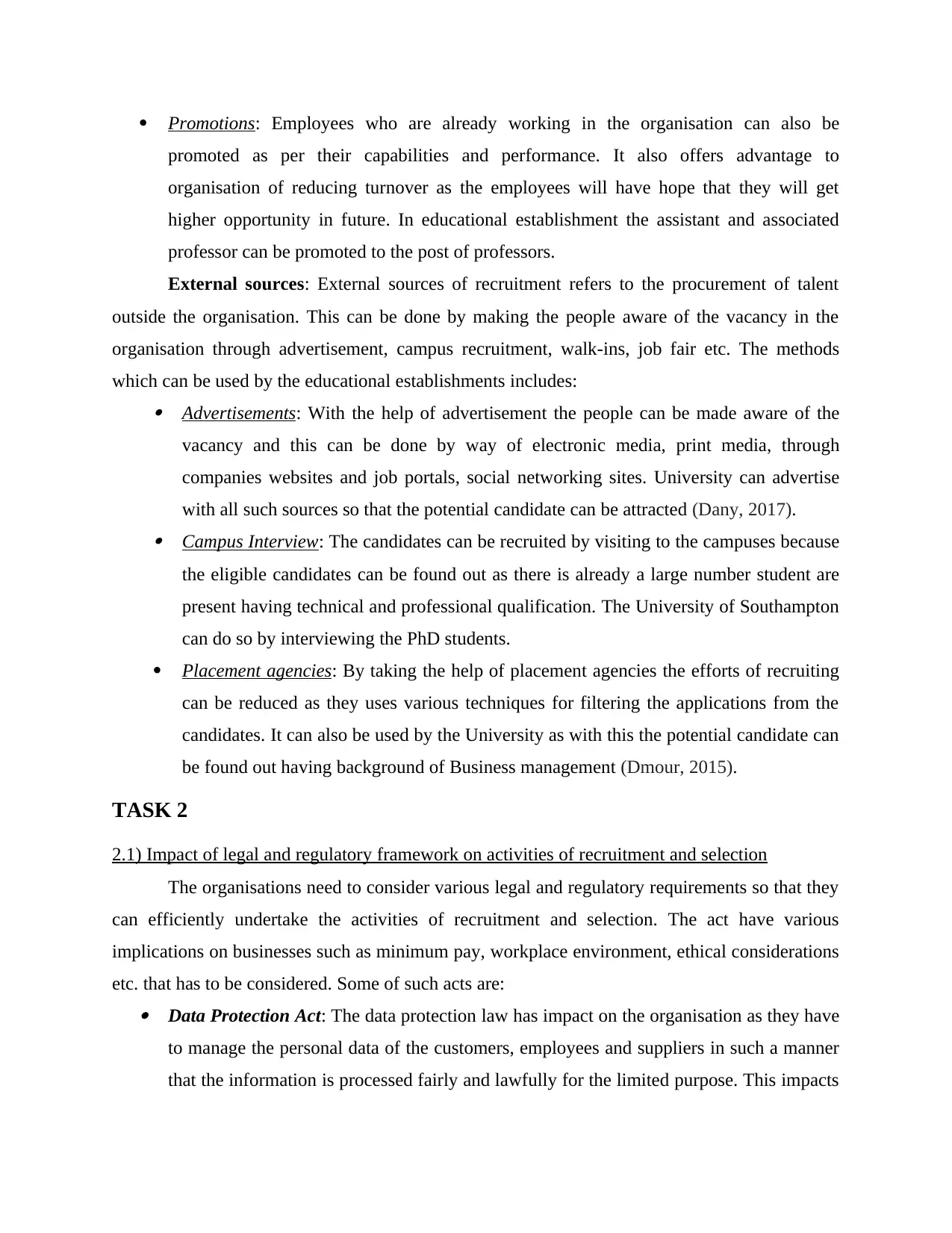
Promotions: Employees who are already working in the organisation can also be
promoted as per their capabilities and performance. It also offers advantage to
organisation of reducing turnover as the employees will have hope that they will get
higher opportunity in future. In educational establishment the assistant and associated
professor can be promoted to the post of professors.
External sources: External sources of recruitment refers to the procurement of talent
outside the organisation. This can be done by making the people aware of the vacancy in the
organisation through advertisement, campus recruitment, walk-ins, job fair etc. The methods
which can be used by the educational establishments includes: Advertisements: With the help of advertisement the people can be made aware of the
vacancy and this can be done by way of electronic media, print media, through
companies websites and job portals, social networking sites. University can advertise
with all such sources so that the potential candidate can be attracted (Dany, 2017). Campus Interview: The candidates can be recruited by visiting to the campuses because
the eligible candidates can be found out as there is already a large number student are
present having technical and professional qualification. The University of Southampton
can do so by interviewing the PhD students.
Placement agencies: By taking the help of placement agencies the efforts of recruiting
can be reduced as they uses various techniques for filtering the applications from the
candidates. It can also be used by the University as with this the potential candidate can
be found out having background of Business management (Dmour, 2015).
TASK 2
2.1) Impact of legal and regulatory framework on activities of recruitment and selection
The organisations need to consider various legal and regulatory requirements so that they
can efficiently undertake the activities of recruitment and selection. The act have various
implications on businesses such as minimum pay, workplace environment, ethical considerations
etc. that has to be considered. Some of such acts are: Data Protection Act: The data protection law has impact on the organisation as they have
to manage the personal data of the customers, employees and suppliers in such a manner
that the information is processed fairly and lawfully for the limited purpose. This impacts
promoted as per their capabilities and performance. It also offers advantage to
organisation of reducing turnover as the employees will have hope that they will get
higher opportunity in future. In educational establishment the assistant and associated
professor can be promoted to the post of professors.
External sources: External sources of recruitment refers to the procurement of talent
outside the organisation. This can be done by making the people aware of the vacancy in the
organisation through advertisement, campus recruitment, walk-ins, job fair etc. The methods
which can be used by the educational establishments includes: Advertisements: With the help of advertisement the people can be made aware of the
vacancy and this can be done by way of electronic media, print media, through
companies websites and job portals, social networking sites. University can advertise
with all such sources so that the potential candidate can be attracted (Dany, 2017). Campus Interview: The candidates can be recruited by visiting to the campuses because
the eligible candidates can be found out as there is already a large number student are
present having technical and professional qualification. The University of Southampton
can do so by interviewing the PhD students.
Placement agencies: By taking the help of placement agencies the efforts of recruiting
can be reduced as they uses various techniques for filtering the applications from the
candidates. It can also be used by the University as with this the potential candidate can
be found out having background of Business management (Dmour, 2015).
TASK 2
2.1) Impact of legal and regulatory framework on activities of recruitment and selection
The organisations need to consider various legal and regulatory requirements so that they
can efficiently undertake the activities of recruitment and selection. The act have various
implications on businesses such as minimum pay, workplace environment, ethical considerations
etc. that has to be considered. Some of such acts are: Data Protection Act: The data protection law has impact on the organisation as they have
to manage the personal data of the customers, employees and suppliers in such a manner
that the information is processed fairly and lawfully for the limited purpose. This impacts
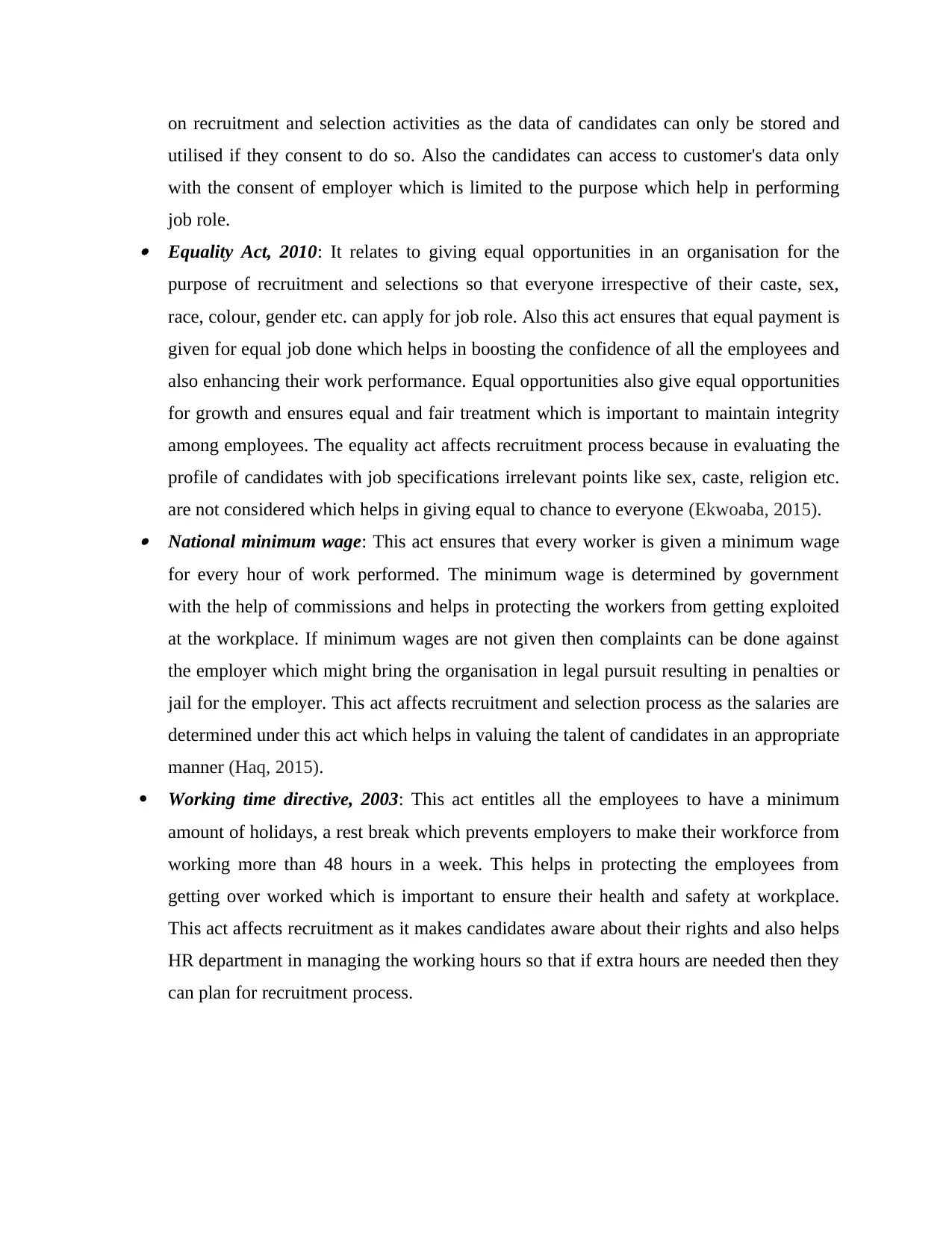
on recruitment and selection activities as the data of candidates can only be stored and
utilised if they consent to do so. Also the candidates can access to customer's data only
with the consent of employer which is limited to the purpose which help in performing
job role. Equality Act, 2010: It relates to giving equal opportunities in an organisation for the
purpose of recruitment and selections so that everyone irrespective of their caste, sex,
race, colour, gender etc. can apply for job role. Also this act ensures that equal payment is
given for equal job done which helps in boosting the confidence of all the employees and
also enhancing their work performance. Equal opportunities also give equal opportunities
for growth and ensures equal and fair treatment which is important to maintain integrity
among employees. The equality act affects recruitment process because in evaluating the
profile of candidates with job specifications irrelevant points like sex, caste, religion etc.
are not considered which helps in giving equal to chance to everyone (Ekwoaba, 2015). National minimum wage: This act ensures that every worker is given a minimum wage
for every hour of work performed. The minimum wage is determined by government
with the help of commissions and helps in protecting the workers from getting exploited
at the workplace. If minimum wages are not given then complaints can be done against
the employer which might bring the organisation in legal pursuit resulting in penalties or
jail for the employer. This act affects recruitment and selection process as the salaries are
determined under this act which helps in valuing the talent of candidates in an appropriate
manner (Haq, 2015).
Working time directive, 2003: This act entitles all the employees to have a minimum
amount of holidays, a rest break which prevents employers to make their workforce from
working more than 48 hours in a week. This helps in protecting the employees from
getting over worked which is important to ensure their health and safety at workplace.
This act affects recruitment as it makes candidates aware about their rights and also helps
HR department in managing the working hours so that if extra hours are needed then they
can plan for recruitment process.
utilised if they consent to do so. Also the candidates can access to customer's data only
with the consent of employer which is limited to the purpose which help in performing
job role. Equality Act, 2010: It relates to giving equal opportunities in an organisation for the
purpose of recruitment and selections so that everyone irrespective of their caste, sex,
race, colour, gender etc. can apply for job role. Also this act ensures that equal payment is
given for equal job done which helps in boosting the confidence of all the employees and
also enhancing their work performance. Equal opportunities also give equal opportunities
for growth and ensures equal and fair treatment which is important to maintain integrity
among employees. The equality act affects recruitment process because in evaluating the
profile of candidates with job specifications irrelevant points like sex, caste, religion etc.
are not considered which helps in giving equal to chance to everyone (Ekwoaba, 2015). National minimum wage: This act ensures that every worker is given a minimum wage
for every hour of work performed. The minimum wage is determined by government
with the help of commissions and helps in protecting the workers from getting exploited
at the workplace. If minimum wages are not given then complaints can be done against
the employer which might bring the organisation in legal pursuit resulting in penalties or
jail for the employer. This act affects recruitment and selection process as the salaries are
determined under this act which helps in valuing the talent of candidates in an appropriate
manner (Haq, 2015).
Working time directive, 2003: This act entitles all the employees to have a minimum
amount of holidays, a rest break which prevents employers to make their workforce from
working more than 48 hours in a week. This helps in protecting the employees from
getting over worked which is important to ensure their health and safety at workplace.
This act affects recruitment as it makes candidates aware about their rights and also helps
HR department in managing the working hours so that if extra hours are needed then they
can plan for recruitment process.
⊘ This is a preview!⊘
Do you want full access?
Subscribe today to unlock all pages.

Trusted by 1+ million students worldwide
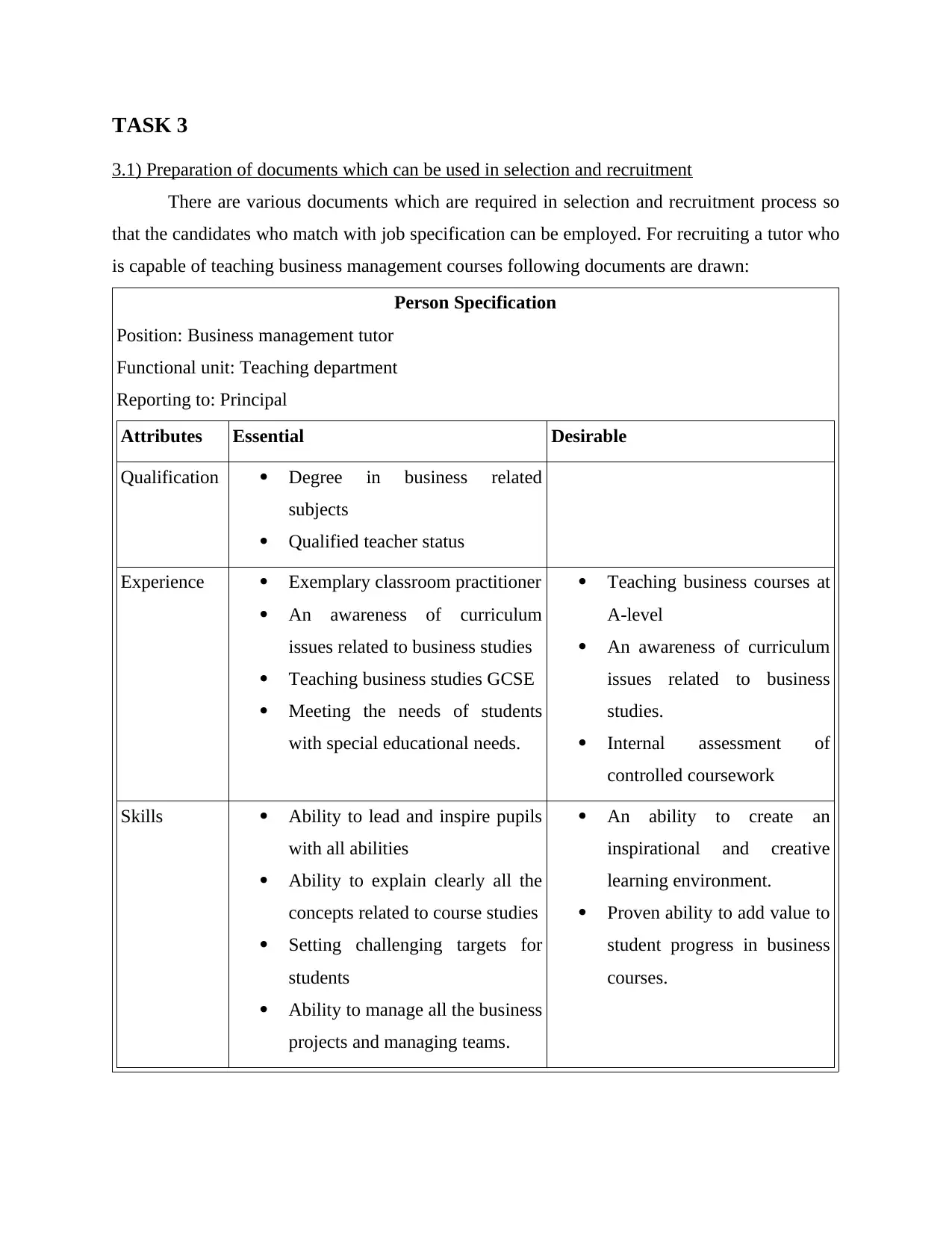
TASK 3
3.1) Preparation of documents which can be used in selection and recruitment
There are various documents which are required in selection and recruitment process so
that the candidates who match with job specification can be employed. For recruiting a tutor who
is capable of teaching business management courses following documents are drawn:
Person Specification
Position: Business management tutor
Functional unit: Teaching department
Reporting to: Principal
Attributes Essential Desirable
Qualification Degree in business related
subjects
Qualified teacher status
Experience Exemplary classroom practitioner
An awareness of curriculum
issues related to business studies
Teaching business studies GCSE
Meeting the needs of students
with special educational needs.
Teaching business courses at
A-level
An awareness of curriculum
issues related to business
studies.
Internal assessment of
controlled coursework
Skills Ability to lead and inspire pupils
with all abilities
Ability to explain clearly all the
concepts related to course studies
Setting challenging targets for
students
Ability to manage all the business
projects and managing teams.
An ability to create an
inspirational and creative
learning environment.
Proven ability to add value to
student progress in business
courses.
3.1) Preparation of documents which can be used in selection and recruitment
There are various documents which are required in selection and recruitment process so
that the candidates who match with job specification can be employed. For recruiting a tutor who
is capable of teaching business management courses following documents are drawn:
Person Specification
Position: Business management tutor
Functional unit: Teaching department
Reporting to: Principal
Attributes Essential Desirable
Qualification Degree in business related
subjects
Qualified teacher status
Experience Exemplary classroom practitioner
An awareness of curriculum
issues related to business studies
Teaching business studies GCSE
Meeting the needs of students
with special educational needs.
Teaching business courses at
A-level
An awareness of curriculum
issues related to business
studies.
Internal assessment of
controlled coursework
Skills Ability to lead and inspire pupils
with all abilities
Ability to explain clearly all the
concepts related to course studies
Setting challenging targets for
students
Ability to manage all the business
projects and managing teams.
An ability to create an
inspirational and creative
learning environment.
Proven ability to add value to
student progress in business
courses.
Paraphrase This Document
Need a fresh take? Get an instant paraphrase of this document with our AI Paraphraser
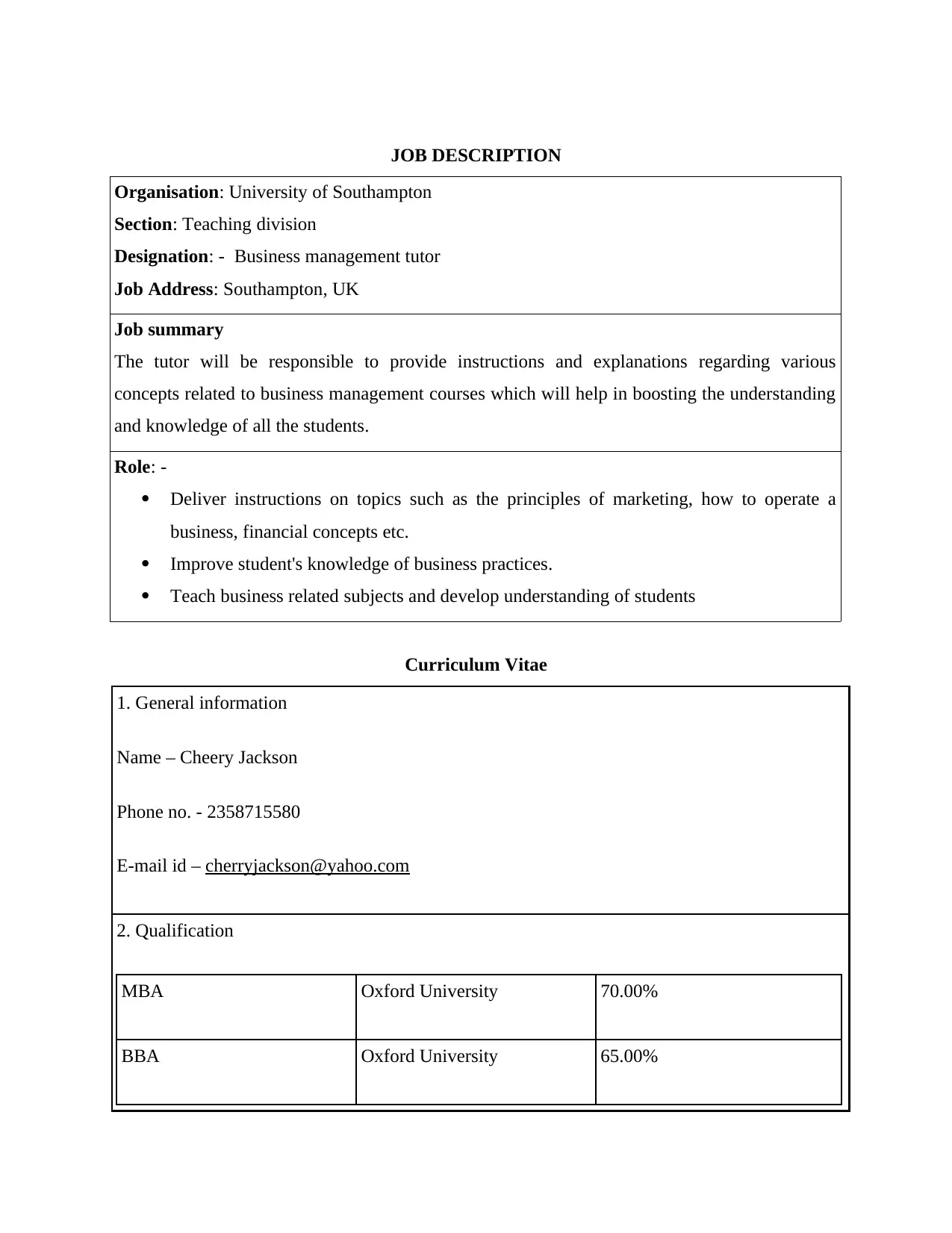
JOB DESCRIPTION
Organisation: University of Southampton
Section: Teaching division
Designation: - Business management tutor
Job Address: Southampton, UK
Job summary
The tutor will be responsible to provide instructions and explanations regarding various
concepts related to business management courses which will help in boosting the understanding
and knowledge of all the students.
Role: -
Deliver instructions on topics such as the principles of marketing, how to operate a
business, financial concepts etc.
Improve student's knowledge of business practices.
Teach business related subjects and develop understanding of students
Curriculum Vitae
1. General information
Name – Cheery Jackson
Phone no. - 2358715580
E-mail id – cherryjackson@yahoo.com
2. Qualification
MBA Oxford University 70.00%
BBA Oxford University 65.00%
Organisation: University of Southampton
Section: Teaching division
Designation: - Business management tutor
Job Address: Southampton, UK
Job summary
The tutor will be responsible to provide instructions and explanations regarding various
concepts related to business management courses which will help in boosting the understanding
and knowledge of all the students.
Role: -
Deliver instructions on topics such as the principles of marketing, how to operate a
business, financial concepts etc.
Improve student's knowledge of business practices.
Teach business related subjects and develop understanding of students
Curriculum Vitae
1. General information
Name – Cheery Jackson
Phone no. - 2358715580
E-mail id – cherryjackson@yahoo.com
2. Qualification
MBA Oxford University 70.00%
BBA Oxford University 65.00%
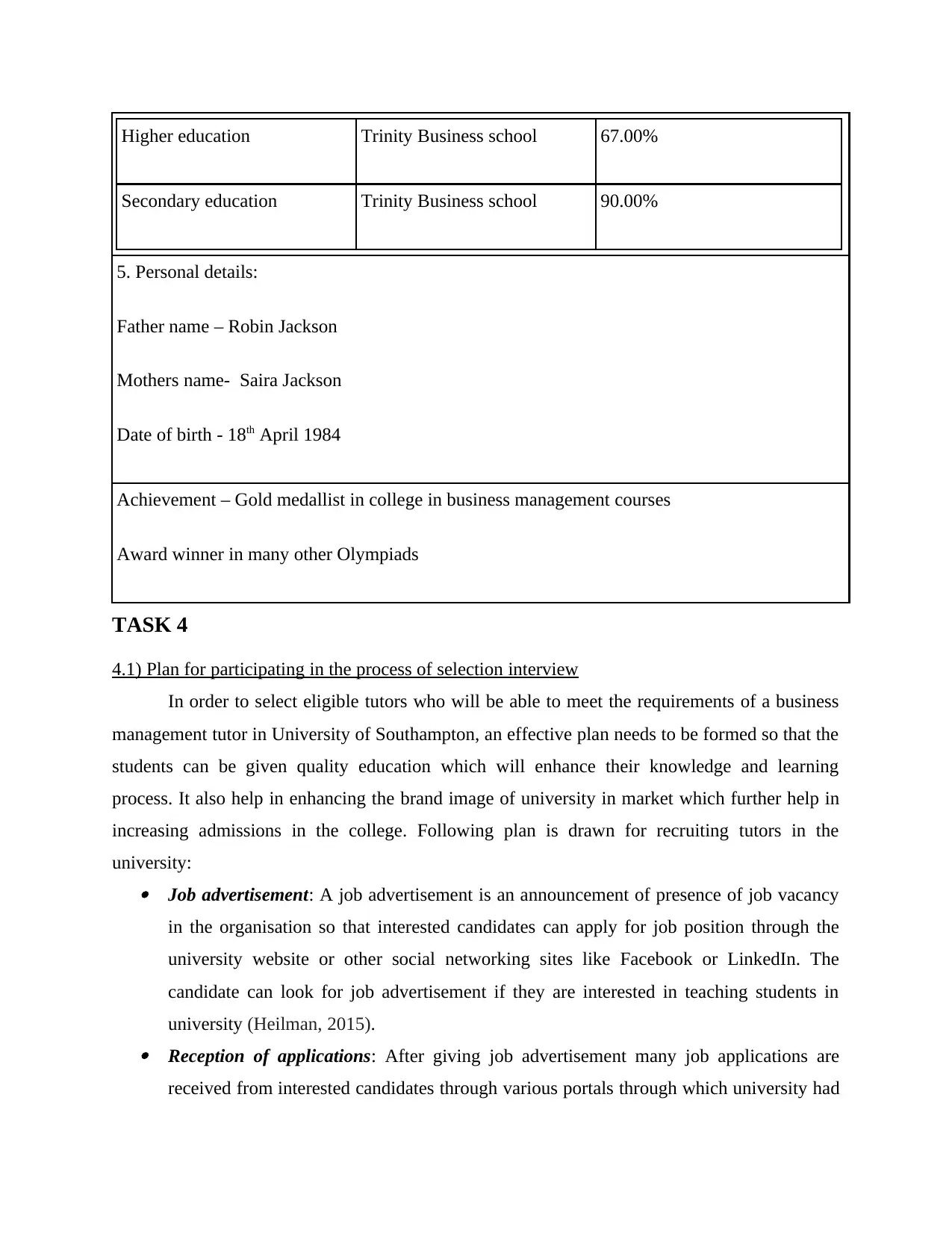
Higher education Trinity Business school 67.00%
Secondary education Trinity Business school 90.00%
5. Personal details:
Father name – Robin Jackson
Mothers name- Saira Jackson
Date of birth - 18th April 1984
Achievement – Gold medallist in college in business management courses
Award winner in many other Olympiads
TASK 4
4.1) Plan for participating in the process of selection interview
In order to select eligible tutors who will be able to meet the requirements of a business
management tutor in University of Southampton, an effective plan needs to be formed so that the
students can be given quality education which will enhance their knowledge and learning
process. It also help in enhancing the brand image of university in market which further help in
increasing admissions in the college. Following plan is drawn for recruiting tutors in the
university: Job advertisement: A job advertisement is an announcement of presence of job vacancy
in the organisation so that interested candidates can apply for job position through the
university website or other social networking sites like Facebook or LinkedIn. The
candidate can look for job advertisement if they are interested in teaching students in
university (Heilman, 2015). Reception of applications: After giving job advertisement many job applications are
received from interested candidates through various portals through which university had
Secondary education Trinity Business school 90.00%
5. Personal details:
Father name – Robin Jackson
Mothers name- Saira Jackson
Date of birth - 18th April 1984
Achievement – Gold medallist in college in business management courses
Award winner in many other Olympiads
TASK 4
4.1) Plan for participating in the process of selection interview
In order to select eligible tutors who will be able to meet the requirements of a business
management tutor in University of Southampton, an effective plan needs to be formed so that the
students can be given quality education which will enhance their knowledge and learning
process. It also help in enhancing the brand image of university in market which further help in
increasing admissions in the college. Following plan is drawn for recruiting tutors in the
university: Job advertisement: A job advertisement is an announcement of presence of job vacancy
in the organisation so that interested candidates can apply for job position through the
university website or other social networking sites like Facebook or LinkedIn. The
candidate can look for job advertisement if they are interested in teaching students in
university (Heilman, 2015). Reception of applications: After giving job advertisement many job applications are
received from interested candidates through various portals through which university had
⊘ This is a preview!⊘
Do you want full access?
Subscribe today to unlock all pages.

Trusted by 1+ million students worldwide
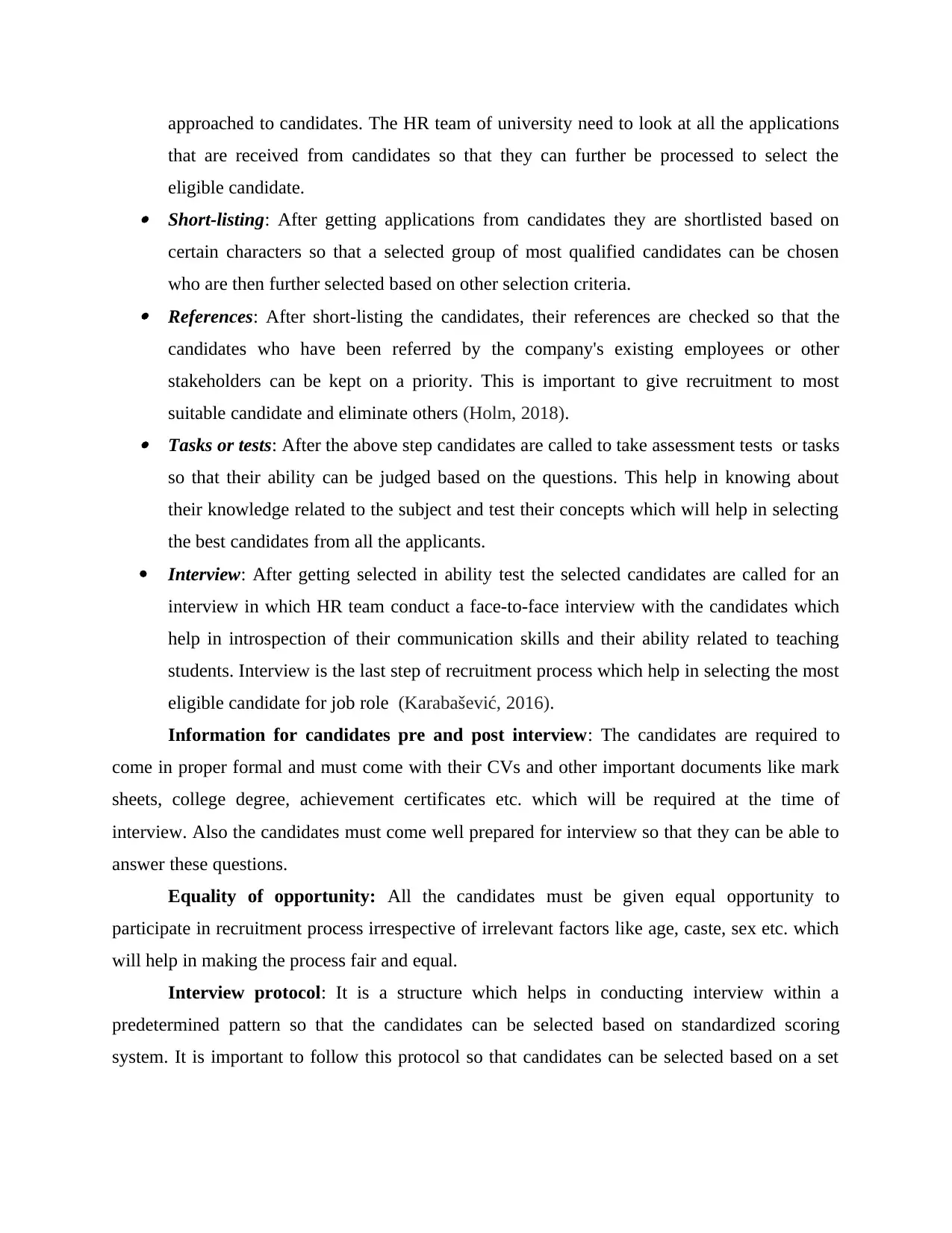
approached to candidates. The HR team of university need to look at all the applications
that are received from candidates so that they can further be processed to select the
eligible candidate. Short-listing: After getting applications from candidates they are shortlisted based on
certain characters so that a selected group of most qualified candidates can be chosen
who are then further selected based on other selection criteria. References: After short-listing the candidates, their references are checked so that the
candidates who have been referred by the company's existing employees or other
stakeholders can be kept on a priority. This is important to give recruitment to most
suitable candidate and eliminate others (Holm, 2018). Tasks or tests: After the above step candidates are called to take assessment tests or tasks
so that their ability can be judged based on the questions. This help in knowing about
their knowledge related to the subject and test their concepts which will help in selecting
the best candidates from all the applicants.
Interview: After getting selected in ability test the selected candidates are called for an
interview in which HR team conduct a face-to-face interview with the candidates which
help in introspection of their communication skills and their ability related to teaching
students. Interview is the last step of recruitment process which help in selecting the most
eligible candidate for job role (Karabašević, 2016).
Information for candidates pre and post interview: The candidates are required to
come in proper formal and must come with their CVs and other important documents like mark
sheets, college degree, achievement certificates etc. which will be required at the time of
interview. Also the candidates must come well prepared for interview so that they can be able to
answer these questions.
Equality of opportunity: All the candidates must be given equal opportunity to
participate in recruitment process irrespective of irrelevant factors like age, caste, sex etc. which
will help in making the process fair and equal.
Interview protocol: It is a structure which helps in conducting interview within a
predetermined pattern so that the candidates can be selected based on standardized scoring
system. It is important to follow this protocol so that candidates can be selected based on a set
that are received from candidates so that they can further be processed to select the
eligible candidate. Short-listing: After getting applications from candidates they are shortlisted based on
certain characters so that a selected group of most qualified candidates can be chosen
who are then further selected based on other selection criteria. References: After short-listing the candidates, their references are checked so that the
candidates who have been referred by the company's existing employees or other
stakeholders can be kept on a priority. This is important to give recruitment to most
suitable candidate and eliminate others (Holm, 2018). Tasks or tests: After the above step candidates are called to take assessment tests or tasks
so that their ability can be judged based on the questions. This help in knowing about
their knowledge related to the subject and test their concepts which will help in selecting
the best candidates from all the applicants.
Interview: After getting selected in ability test the selected candidates are called for an
interview in which HR team conduct a face-to-face interview with the candidates which
help in introspection of their communication skills and their ability related to teaching
students. Interview is the last step of recruitment process which help in selecting the most
eligible candidate for job role (Karabašević, 2016).
Information for candidates pre and post interview: The candidates are required to
come in proper formal and must come with their CVs and other important documents like mark
sheets, college degree, achievement certificates etc. which will be required at the time of
interview. Also the candidates must come well prepared for interview so that they can be able to
answer these questions.
Equality of opportunity: All the candidates must be given equal opportunity to
participate in recruitment process irrespective of irrelevant factors like age, caste, sex etc. which
will help in making the process fair and equal.
Interview protocol: It is a structure which helps in conducting interview within a
predetermined pattern so that the candidates can be selected based on standardized scoring
system. It is important to follow this protocol so that candidates can be selected based on a set
Paraphrase This Document
Need a fresh take? Get an instant paraphrase of this document with our AI Paraphraser
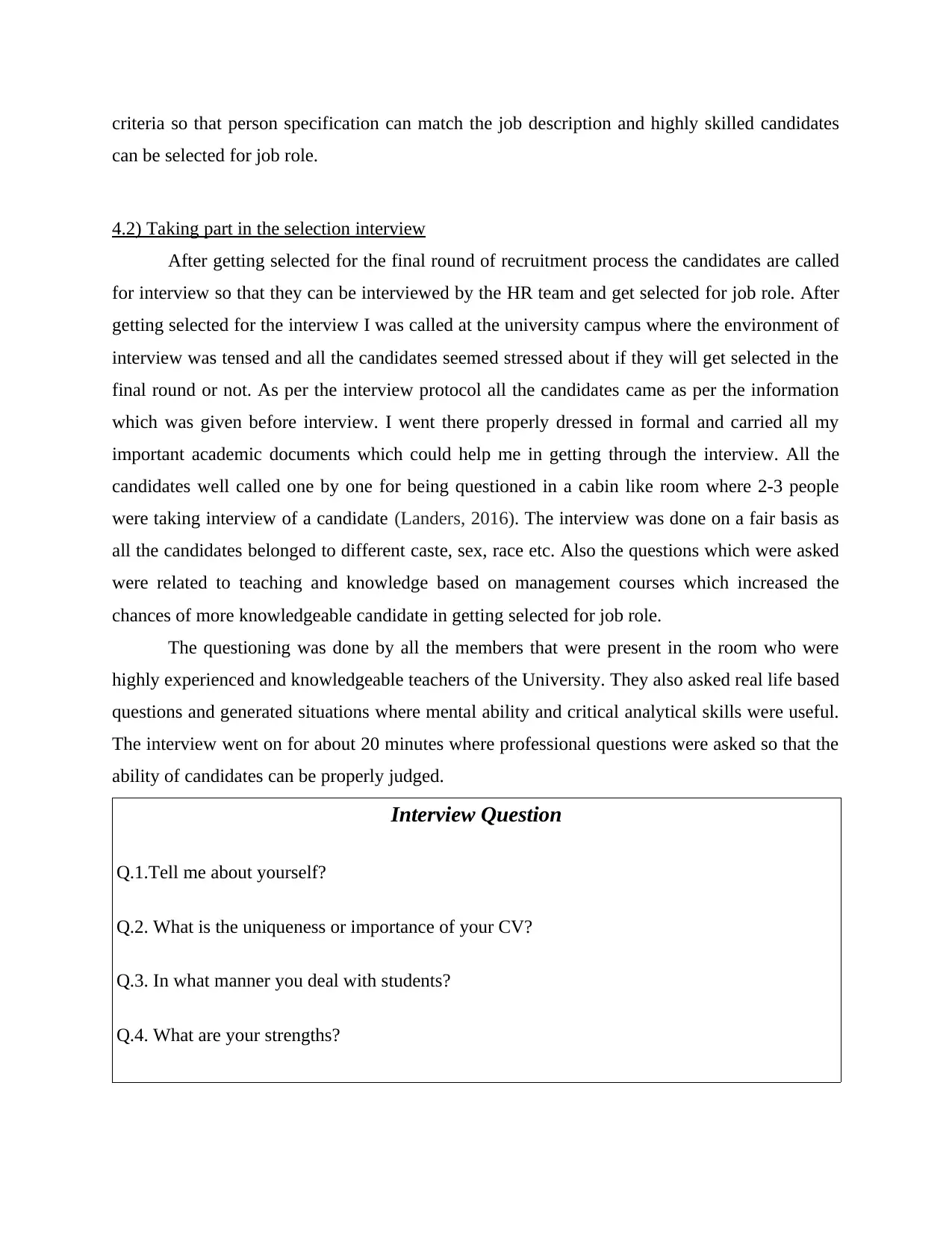
criteria so that person specification can match the job description and highly skilled candidates
can be selected for job role.
4.2) Taking part in the selection interview
After getting selected for the final round of recruitment process the candidates are called
for interview so that they can be interviewed by the HR team and get selected for job role. After
getting selected for the interview I was called at the university campus where the environment of
interview was tensed and all the candidates seemed stressed about if they will get selected in the
final round or not. As per the interview protocol all the candidates came as per the information
which was given before interview. I went there properly dressed in formal and carried all my
important academic documents which could help me in getting through the interview. All the
candidates well called one by one for being questioned in a cabin like room where 2-3 people
were taking interview of a candidate (Landers, 2016). The interview was done on a fair basis as
all the candidates belonged to different caste, sex, race etc. Also the questions which were asked
were related to teaching and knowledge based on management courses which increased the
chances of more knowledgeable candidate in getting selected for job role.
The questioning was done by all the members that were present in the room who were
highly experienced and knowledgeable teachers of the University. They also asked real life based
questions and generated situations where mental ability and critical analytical skills were useful.
The interview went on for about 20 minutes where professional questions were asked so that the
ability of candidates can be properly judged.
Interview Question
Q.1.Tell me about yourself?
Q.2. What is the uniqueness or importance of your CV?
Q.3. In what manner you deal with students?
Q.4. What are your strengths?
can be selected for job role.
4.2) Taking part in the selection interview
After getting selected for the final round of recruitment process the candidates are called
for interview so that they can be interviewed by the HR team and get selected for job role. After
getting selected for the interview I was called at the university campus where the environment of
interview was tensed and all the candidates seemed stressed about if they will get selected in the
final round or not. As per the interview protocol all the candidates came as per the information
which was given before interview. I went there properly dressed in formal and carried all my
important academic documents which could help me in getting through the interview. All the
candidates well called one by one for being questioned in a cabin like room where 2-3 people
were taking interview of a candidate (Landers, 2016). The interview was done on a fair basis as
all the candidates belonged to different caste, sex, race etc. Also the questions which were asked
were related to teaching and knowledge based on management courses which increased the
chances of more knowledgeable candidate in getting selected for job role.
The questioning was done by all the members that were present in the room who were
highly experienced and knowledgeable teachers of the University. They also asked real life based
questions and generated situations where mental ability and critical analytical skills were useful.
The interview went on for about 20 minutes where professional questions were asked so that the
ability of candidates can be properly judged.
Interview Question
Q.1.Tell me about yourself?
Q.2. What is the uniqueness or importance of your CV?
Q.3. In what manner you deal with students?
Q.4. What are your strengths?
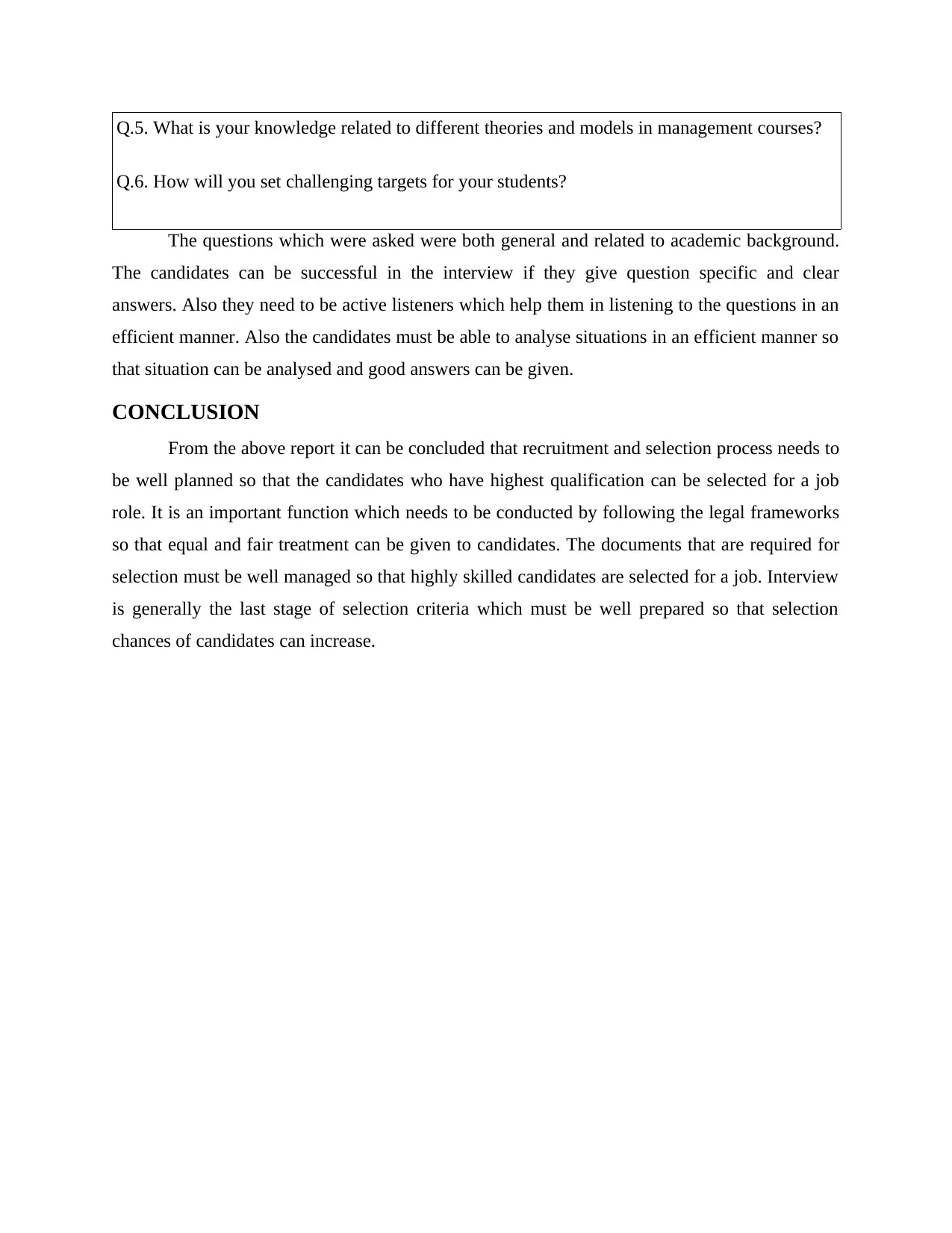
Q.5. What is your knowledge related to different theories and models in management courses?
Q.6. How will you set challenging targets for your students?
The questions which were asked were both general and related to academic background.
The candidates can be successful in the interview if they give question specific and clear
answers. Also they need to be active listeners which help them in listening to the questions in an
efficient manner. Also the candidates must be able to analyse situations in an efficient manner so
that situation can be analysed and good answers can be given.
CONCLUSION
From the above report it can be concluded that recruitment and selection process needs to
be well planned so that the candidates who have highest qualification can be selected for a job
role. It is an important function which needs to be conducted by following the legal frameworks
so that equal and fair treatment can be given to candidates. The documents that are required for
selection must be well managed so that highly skilled candidates are selected for a job. Interview
is generally the last stage of selection criteria which must be well prepared so that selection
chances of candidates can increase.
Q.6. How will you set challenging targets for your students?
The questions which were asked were both general and related to academic background.
The candidates can be successful in the interview if they give question specific and clear
answers. Also they need to be active listeners which help them in listening to the questions in an
efficient manner. Also the candidates must be able to analyse situations in an efficient manner so
that situation can be analysed and good answers can be given.
CONCLUSION
From the above report it can be concluded that recruitment and selection process needs to
be well planned so that the candidates who have highest qualification can be selected for a job
role. It is an important function which needs to be conducted by following the legal frameworks
so that equal and fair treatment can be given to candidates. The documents that are required for
selection must be well managed so that highly skilled candidates are selected for a job. Interview
is generally the last stage of selection criteria which must be well prepared so that selection
chances of candidates can increase.
⊘ This is a preview!⊘
Do you want full access?
Subscribe today to unlock all pages.

Trusted by 1+ million students worldwide
1 out of 13
Related Documents
Your All-in-One AI-Powered Toolkit for Academic Success.
+13062052269
info@desklib.com
Available 24*7 on WhatsApp / Email
![[object Object]](/_next/static/media/star-bottom.7253800d.svg)
Unlock your academic potential
Copyright © 2020–2025 A2Z Services. All Rights Reserved. Developed and managed by ZUCOL.





